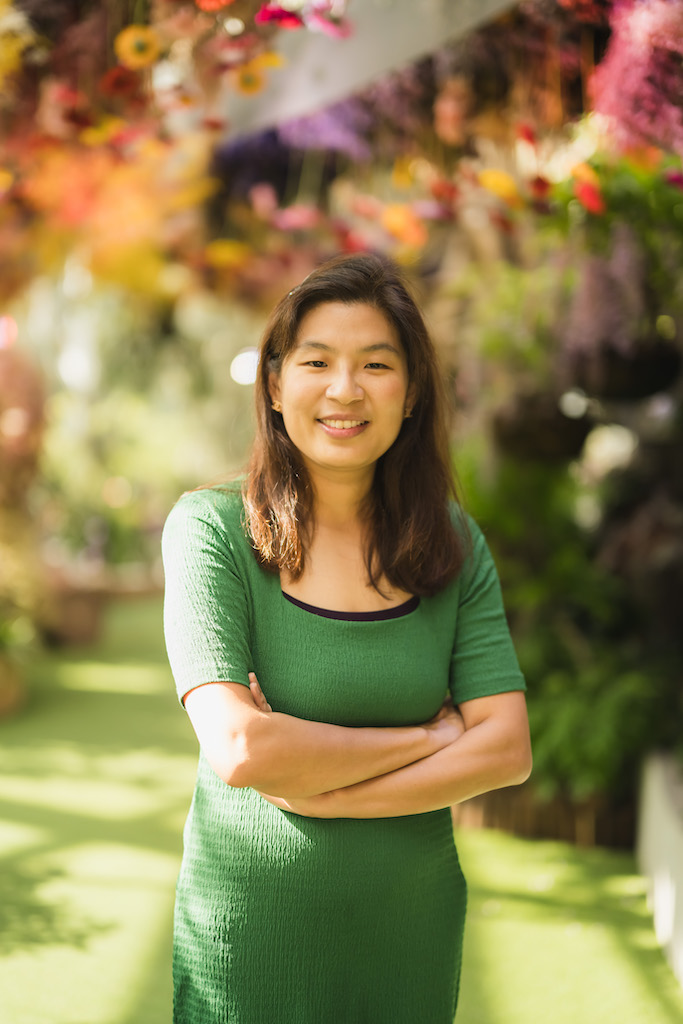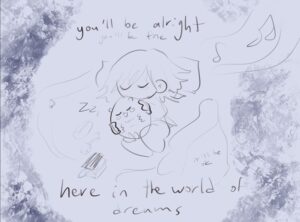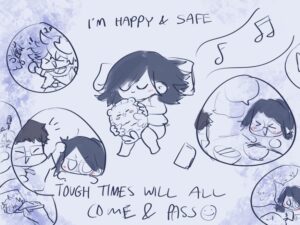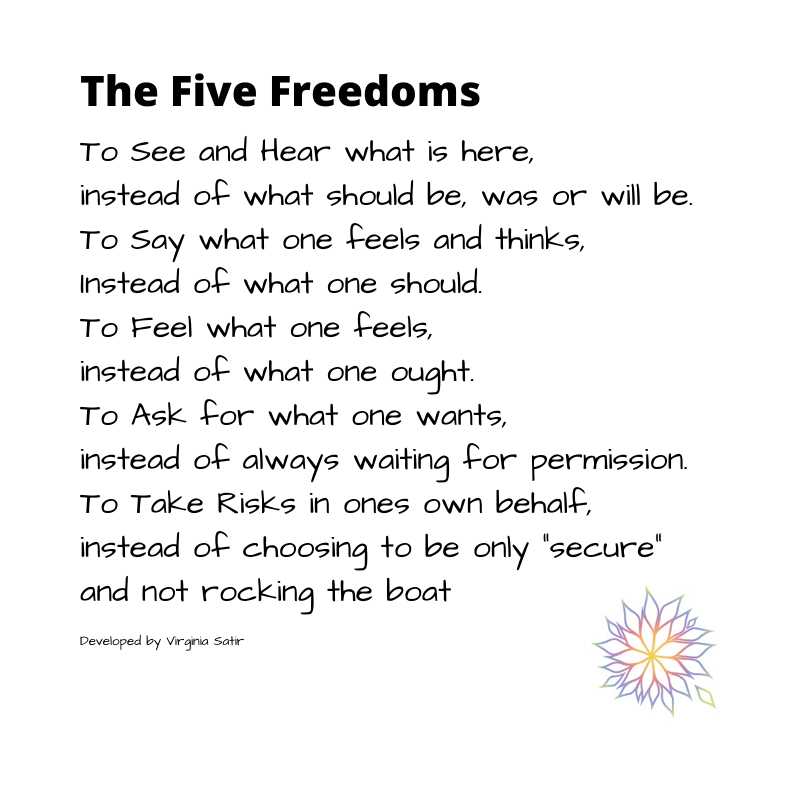
Using the Satir Model to bring about Transformational Change by Mylene Lee Pei-En
Client info (“S”)
Biodata: Female, 21 years old
Presenting Problem: Losing motivation in her studies. Feeling stressed and pressured to church out new art pieces to sell for her side business. Also has thoughts of ending her life. S is worried about her father’s anger issues as he would shout when she is unable to live up to her father’s expectations in terms of her academics as a result, this has led her to have many breakdowns. She came for counselling because she wanted to reduce her depressive symptoms and to explore healthier coping mechanism.
Making contact with S
I made contact with S inner world by first working on building safety and resourcing her such as acknowledging her by her name, getting to know S individually and the side business of art she is involved in. I knew I made contact because I noticed her vocal tone increased and instead of looking down there was a smile on her face.
Setting collaboratively, positively directional, intrapsychic and interactive goals
The final therapeutic goal: S wants to reduce her depressive symptoms and explore healthier coping mechanisms. In turn she is hoping to have more energy and happiness in her life. These were the sessional and incremental goals for the 8 sessions we had (bearing in mind that the 1st being the intake session).
| Session | Sessional Goals | Incremental Goals |
| 2 | To use S’s resource of art to draw a safe place for herself | Drawing of the safe place for herself (see Appendix C) |
| 3 | Helping S understand her own yearnings when she begged her friend not to leave after a quarrel, they had | Able to acknowledge her own yearnings |
| 4 | Practicing in session how to meet her own yearning (giving her the space to affirm herself) | To be able to affirm herself in session and daily till the next counselling session |
| 5 | Learning to tap on her own resources when she is triggered in actual situations | Sharing of specific incidents and showing how she made use of her resources to meet her yearnings |
| 6 | Having the realization her brother is a resource for her | Extending her gratitude to her brother both in session and after the session |
| 7 | Learning to affirm and acknowledge her own efforts in her academics | Affirming and acknowledging her own efforts on a daily basis |
| 8 | Consolidating all her internal and external resources and updating her drawing | Her revised drawing incorporating all her internal and external resources
(See Appendix D) |
Making the therapy experiential for myself and for S:
By using the process questions in the Satir iceberg focusing on S’s body sensations in the present moment as well as the use of self. By keeping myself grounded and being aware of how the session is impacting my body sensation too. Secondly, I would feel the energy and differentiate is the energy coming from myself or from S and then if it is from S, to pick it up and reflect to her.
Process Assessment of S’s relationship and internal dynamics conceptualized through the Satir Model
| Before Counselling | After 8 sessions | |
| Behaviour | Breakdowns, depressive symptoms, and mood swings because of the pressure her father placed on her to do well in her studies | Lesser breakdowns, depressive episodes and mood swings |
| Survival Stances | Placating stance when her father yelled at her | No longer placates |
| Body Sensation | Tightness in the chest, shoulders and even choking in the throat | No more tightness in the chest, shoulders and no more choking feeling in the throat |
| Feelings | Anxious when her father shouts at her or has a quarrel with her friends | No longer feel anxiety |
| Feeling about feelings | Sadness | No longer feel sadness |
| Perceptions of… | self: I am not worthy of love, unimportant, lonely.
family members and friends: They are rude, hypocritical, do not respect my boundaries. world: like a big block obstructing her view. |
Self: Worthy of love, important and not lonely
Family members and friends: Still sees her father as rude, also realize he is emotionally unavailable to meet her yearnings. However, realizes her older brother and friends love her. world: Changed to a thin presence (where she can see through it) |
| Beliefs | I am unlovable | I am loveable |
| Expectations of… | self: I should be loved and important.
Others: they should be there for me, have heart to heart talk with me Others expect of S: to get well, have lesser breakdowns and depressive episodes |
self: I should be loved and important |
| Yearnings | love, safety, connection, acceptance | |
| Self | Low self-esteem and self-concept | Internal resources to love herself and her friends and her brother as her external resources who love her |
Changes I worked on during therapy
One change I worked on during therapy is knowing when she activates the placating stance she has discounted self. As such the specific changes I worked on is educating S on how she can use her own internal resources to meet her own yearnings so as to bring self-back into the equation. Secondly, I also wanted her to be aware of the external resources (eg. her older brother) she can tap on to help meet her yearnings too.
Interventions and Techniques used
The interventions and techniques I used in sessions included:
(1) Psycho-educating S on the different coping stances
Reason for choice: Hoping S would realize the reactions people have towards her are a result of their coping stance being activated when they are in stress. I used it to help S realize her father activated his blaming stance because he was stressed out at work due to poor sales. This resulted in his behaviour of shouting at his family members (especially at S).
S’s feedback: helped her to not take things personally whenever she sees her father’s coping stance being activated.
(2) Drawing out the Satir iceberg visually and exploring each layer of the iceberg pertaining to a specific incident where she had a quarrel with her friend.
Reason for choice: Chose to draw the Satir iceberg visually because from the sessions I gather she is more inclined visually. I used it to help her see what is going on in her internal experience that caused her to beg her friend when she has a quarrel with her.
S’s feedback: Knowing this Satir’s iceberg has provided her a tool she can use to process her own internal experience when she is triggered by something. It has also inspired S to think about what her own internal resources are that she can tap on to meet her own yearnings.
(3) Using visualization to get S to affirm herself in session.
Reason for choice: S shared about how she experienced resentment whenever others are emotionally unavailable to meet her needs. Her hope was to see the resentment shifts from a block to a thin presence. Using the process questions in the Satir iceberg, S was hoping to change her belief from “I am unimportant” to “I am important.” When I asked her what it takes, she said affirmation. So, I invited S to practice affirming self experientially in session and then using that same energy and conviction to learn to affirm herself on a daily basis.
S’s feedback: S said she found it liberating and she realized she does not need others to affirm her. She is motivated to affirm herself on a daily basis. S also said when she realized she has her resource of self-affirmation, her perception of her resentment also shifted from a block to a thin presence.
(4) Using visualization to get her to extend gratitude to her older brother in session.
Reason for choice: S shared rejection from her father and how she desires for her father to be there for her and to have heart to heart talk with him. I made use of self in therapy and reflected to S that these desires can be found in her older brother. I wanted this insight to be experiential for S, thus I invited S to first visualize herself expressing gratitude to her older brother. Next in the visualization exercise, I got her to explicitly thank her older brother out loud for always being there for her and someone she can have a heart-to-heart talk with.
S’s feedback: She shared when she was talking about her father, she felt a sore throat coming in (choking), however when she talked about her older brother, she felt her sore throat recover.
(5) Satir’s self-mandala
Reason for choice: I chose this technique because it is visual, and I wanted to use Satir’s self-mandala to explore with S on the different aspects to help her prevent burn out and depression. I chose this technique again because it is visual.
S’s feedback: S liked the Satir self-mandala because it is a visual checklist she can always refer to and check in with herself on a weekly basis how she is doing in these areas on a scale of 0 to 5 as well as brainstorm the steps she can take to nurture these aspects can help her to grow in being a more congruent self.
Changes S have witnessed in herself
She is having better emotional management in terms of smiling more in session and experiencing lesser breakdowns. She is more confident of her art pieces. The result of these changes intrapsychically is she is now in-charge of all her internal experiences in her iceberg. She is also able to tap on her own internal resources to meet her yearnings. An example is loving and affirming self (“I am loved.”) and acknowledging her own efforts.
The result of these changes interactively is she has healthier relationships with her friends and also realizes in fact she has lots of people who love and care for her. With her father, she does not take his comments personally. With her older brother, she fosters a closer bond with him and grateful for his presence. It has also helped her not to be so affected by her father being emotionally unavailable for her. Lastly in terms of her art, she just wants to use her art to bless others, no longer feeling pressurized to churn out art pieces just to make money. With her counsellor (which is me), she expresses her gratitude in terms of writing an appreciation note and giving me a few of her art-pieces for keepsake and to bless me (See Appendix E).
Anchoring the Changes made
S talked about her yearning for safety and in the session, I ascertained what resources give her safety. She shared it is herself in bed with her blanket, plushie, while having encouraging words surrounding her. I anchored the 2nd session by affirming her resources and getting her to draw the image of safety she described in session. In the 3rd session I anchored the changes further by asking S what has been different for her since she has drawn out the image of safe place for herself. S shared when she realizes her yearning of safety is met in the drawing, she is able to see her parents as them trying their best (eg. seeing her mother expressing her concerns for her by sending her motivational quotes each day or her father asking her if she would like to talk to people who have overcome depression). In the 4th session where she practiced affirming herself, I anchored by reinforcing the changes by checking in on feelings, beliefs, perceptions. I also anchored by emphasizing to her through my words and tone that I am so happy she has found the resource of affirming herself. In the 5th session S shared she experienced lesser breakdowns, I asked her to share a specific incident, she shared when she was flooded with thoughts like “no one loves me”, she remembered her anchors, “affirming self that she is loved”, the image of the safe place etc. I anchored that session by asking her who she would be celebrating with and how. She indicated with her older brother and also school friends through a meal, with her online community through sending of personal messages. In the 6th session after S visually expressed her gratitude to her older brother in session, I anchored by using imagery rehearsal with S on how she would express the exact words (thank you for being there for me and someone I can have a heart to hear talk with) and then checking in on her changes in feelings, beliefs, perceptions, expectations etc. In the next session I further anchored the changes by checking in on S’s experience when she physically expressed her gratitude to her older brother. Her older brother responded, “this is family.” I reinforced the changes by emphasizing the word with my tone of voice, “this is family” and checking in on her body sensations and what she is connecting with. S feedbacked “she felt soft, warmth and bubbly.” Initially she thought that safety was found in an image, however her yearning for safety is met in her family member. In her 8th session, after consolidating all of her internal and external resources, I anchored it by asking her if she would like to update her image of a safe place, what she would add. She says she would like to add her external resources (like her friends and her brother to the image). In the 8th session which is also the closing session, I also emphasize and affirmed to S of the specific changes she made. S also feedbacked how the sessions have provided her so many resources (including herself) she can tap on to meet her own yearnings.
Homework Assigned:
The homework I assigned for the 2nd session is to draw an image that represents a safe place for her (based on the things she mentioned in session that keeps her safe). I assigned this homework because I want to tap on S’s internal resources (which is her love for art) to empower her to meet her own yearnings. Also knowing that she is more visual and loves art, I felt she will be more motivated to do the homework. Secondly, I also wanted to provide her with a visual physical image she can always turn to as her anchor when she is triggered and hopefully this image can also be etched on her mind. In the 3rd session, after psycho-educating her on Satir coping stances and also the layers in the iceberg, the homework I assigned was getting her to be more aware of the layers in her iceberg experience. I assigned this homework because I want to help her be more in-charge of her own body sensations, feelings, perceptions, expectations, yearnings. Only by being aware of her own yearnings, she can begin to tap on her resources to meet her yearnings. In the 4th session, I asked her to affirm herself on a daily basis and as she affirms herself notice what is happening within her and what she connects with. I assigned this homework because I wanted her to continue to practice affirming herself and also hoping as she connects with affirming herself experientially, it will become something second nature for her. In the 5th session, to organize celebrations with those people she mentioned in session she would like to celebrate her progress with. I chose this homework because it is positively directional, changed-focused and experiential (because it would bring about a different internal experience for her). In the 6th session, the homework was to express her gratitude to her older brother and explicitly thanking him for being there for her and someone she can have heart to heart talk with. I chose this homework because I want to further anchor her that her older brother is a strong resource for her as well as also teaching her to practice expressing gratitude for others. I believe expressing gratitude brings positive energy into one’s lives and empowers them (as I remembered one of her presenting issues is low motivation). In the 8th session as it was also the closing session, after getting her to consolidate all her resources she has gained. S shared the greatest change for her is learning to love herself. The second change is how she can use her art to be an impact or blessing to the people around her. Once again, I wanted her to have a visual reminder of the progress she has made so I referred her back to the image of safe place and invited her to update the image. S said instead of depicting her safe place as being alone, now she wants to add being surrounded by people loving her (and with the activities she loves).
What was done well:
Firstly, at our organization when S first came for session, we use the general health questionnaire and gave a score. S scored 42 (high). However, after 8 sessions, her score dropped to 17 (low). I believe I have helped her to reduce her depressive symptoms and explore healthier coping mechanisms. Secondly, I have helped her to explore resources through the process questions in the iceberg to help her meet her own yearnings. Thirdly, I have built a loving and nurturing environment by first meeting my own yearnings (so that S’s yearnings of love, connection, acceptance) can be met in session and thus it gives her the courage to face her issues. Fourthly, I have also used the self in therapy, trusting my intuition to help S move in a positively directional and change focused way through the anchoring of changes and also the homework that were assigned. As a result, I could see she has higher self-esteem, is more responsible (in terms of being in charge of her own internal world) and most of all more congruent.
What I would change:
Sadly, I do not have more sessions with her after the 8th session because I left the organization. I wish I had more time to work with her especially in terms of her relationship with her father. I did not get the chance to explore her relationship with her father, as I sensed she is not ready as of yet. Thus, I used the session to build up both her internal and external resources.
What I learnt about therapy:
What I learnt about therapy is the importance of assessing resources through yearnings. An example with S, using visual methods like art, drawing out of the iceberg, the image of the coping stances, visualization exercise, Satir self-mandala all connected with her core essence thus it motivated her to be changed focused in a positively directional way. Secondly, I am recognizing how important it is for the therapist to be congruent, so that the therapist can meet the yearnings of her client. Meeting the yearnings of a client is very important in helping to build safety and for relationship building so that the client can work on his or her issues. Thirdly, I am also learning how important it is to practice in session through visualization and then checking in using the process questions on the person’s internal world the changes that the client made in session. An example is when S realizes she can affirm herself she can change her belief from I am unimportant to important. And anchoring it by getting S to affirm herself in session and then checking in on her internal world. And also seeing the changes she made intrapsychically also impacting her interactively (like having closer relationships with her friends and brother).
Appendix C: S’s 1st image of safe place drawn after 2nd therapy session

June 2023’s Image:
Caption: “You’ll be alright, you’ll be fine, here in the world of dreams”
Image description:
Drawing depicts my definition of what a safe space means to me. I am crying in my sleep, while hugging my merlion plushie. On the same bed, there are things like my phone, music song notes and a blanket scattered around. These are also things I find comfort and safety in.
Appendix D: S’s revised image of safe place after 8 therapy sessions

October 2023’s Image:
Caption: “I’m happy & safe. Tough times will all come & pass 😊”
Image Description:
This drawing has a similar premise as the one in June, except that I am now smiling while being surrounded with bubbles of instances that cheered me up.
Starting from the top on the left side, playing online games like Genshin Impact with friends has cheered me up considerably. Drawing art of my favourite characters as stickers and keychains allowed me to de-stress and motivate myself. My older brother teasing and caring for me reminds me that I am loved, and that even if my self-doubt thinks otherwise, my heart knows that I am able to love myself.
On the right side, hanging out with friends through study sessions and eating lunch together has also made me more happy. The use of social media and messaging apps gives me a virtual safe space, where I am surrounded by the artworks I like and the friends I care for, thus making me feel happy and safe.

An appreciation note and stickers of her art pieces for my keepsake
A Written Case Study by Lee Pei-En (Mylene), Singapore 2023 – Mylene graduated with a Master of Arts (Counseling) degree as well as has received extensive training in Satir Transformational Systemic Therapy. She is both a registered Counsellor and Clinical Supervisor with the Singapore Association for Counselling. She is also an accredited Certified Coach with the International Coaching Federation.



